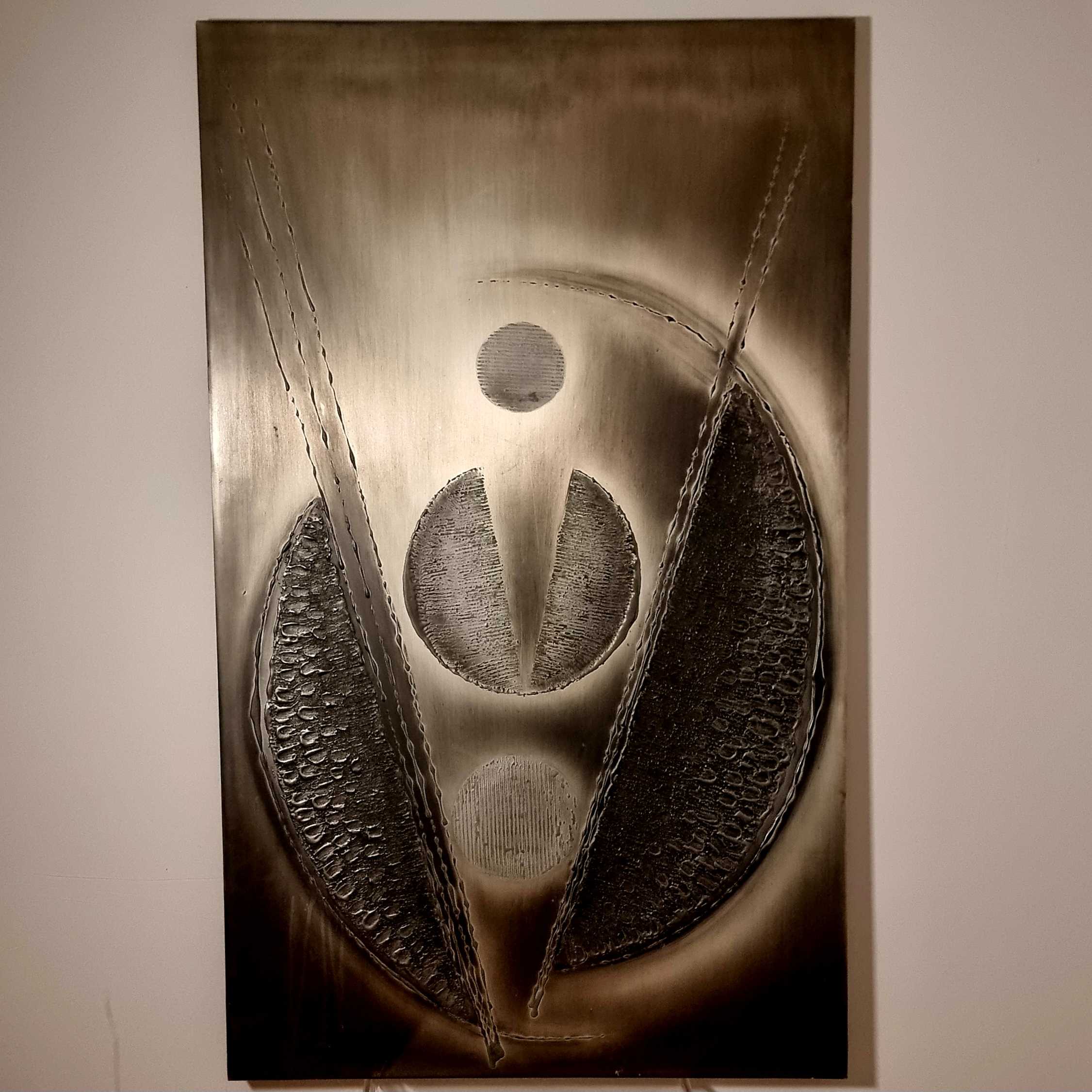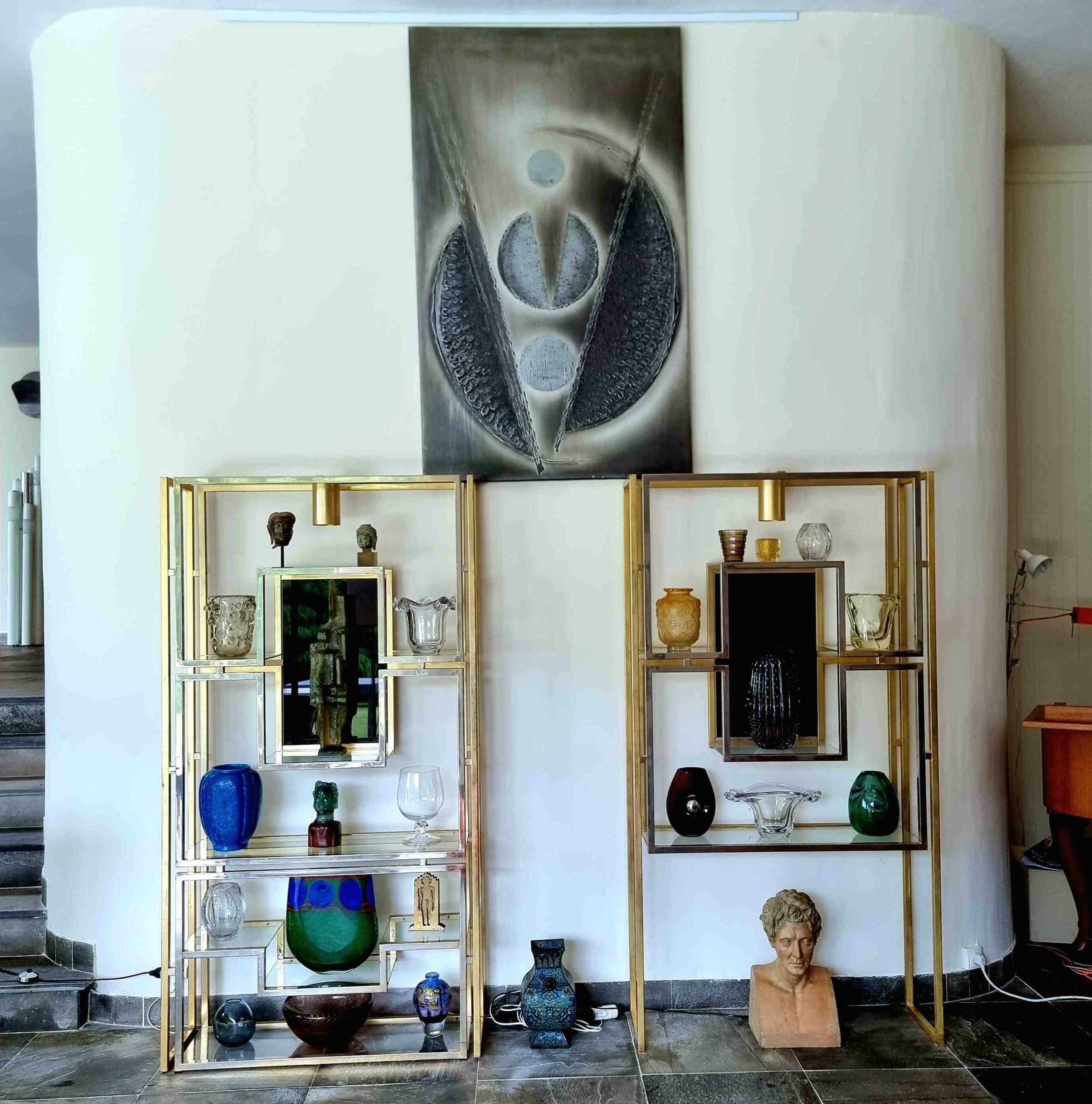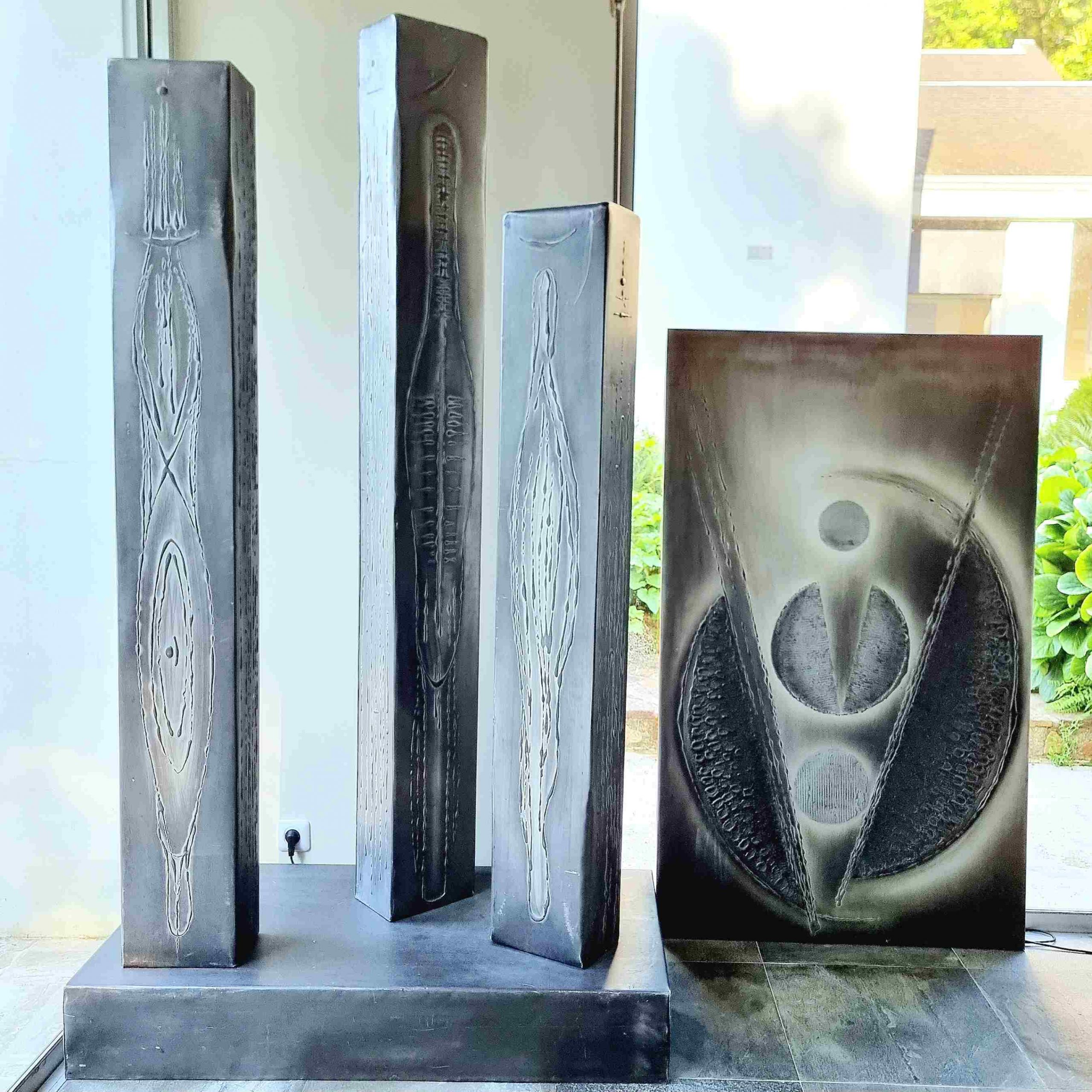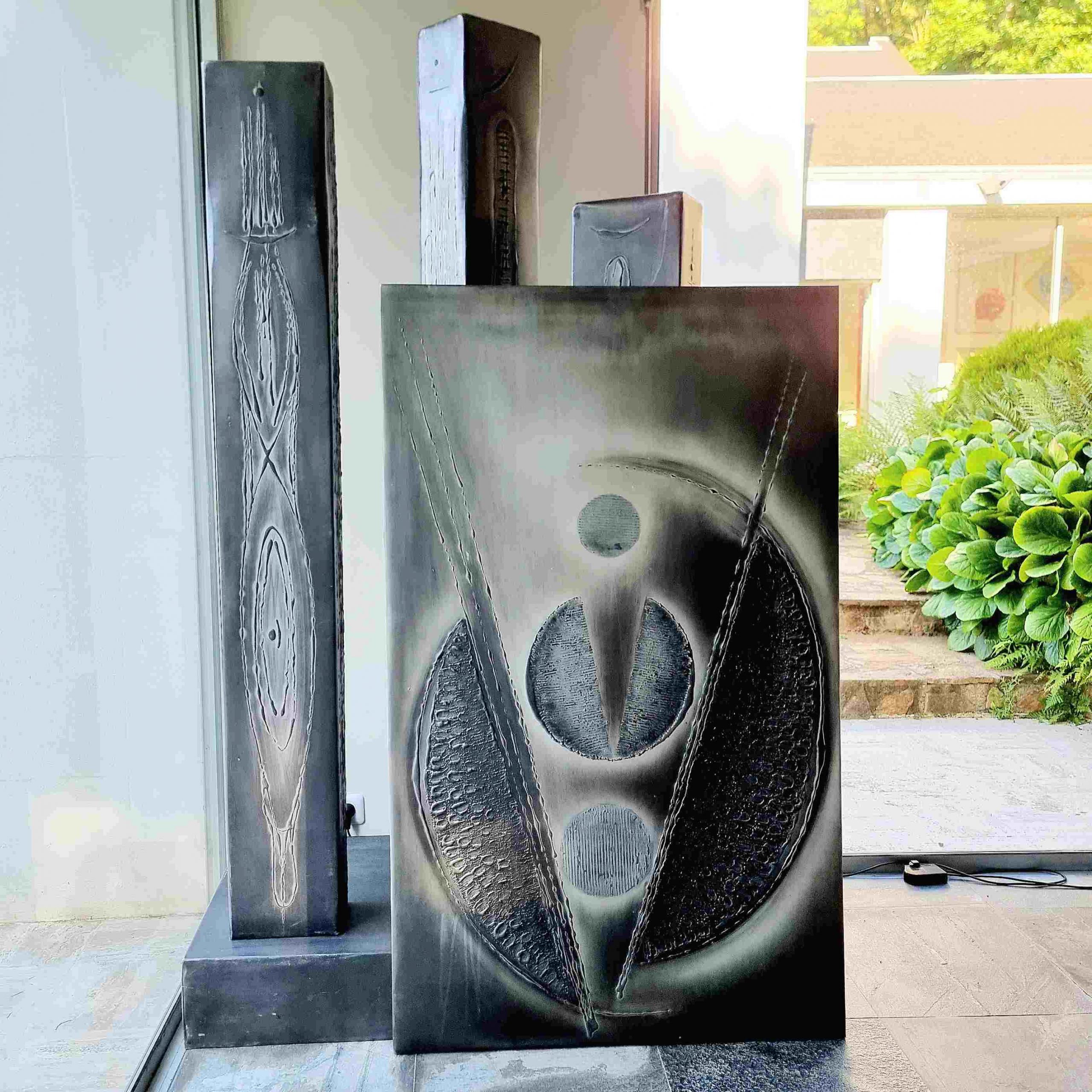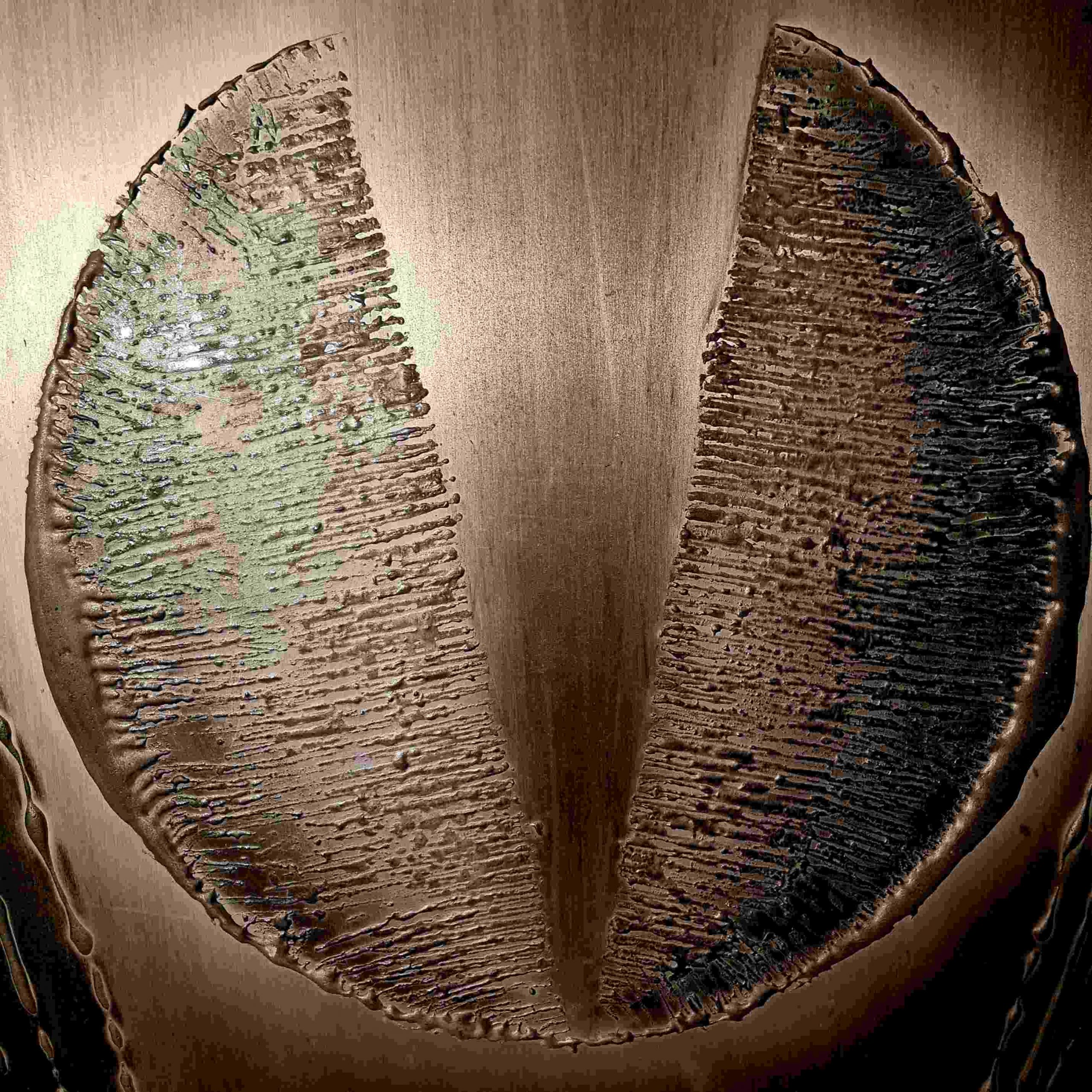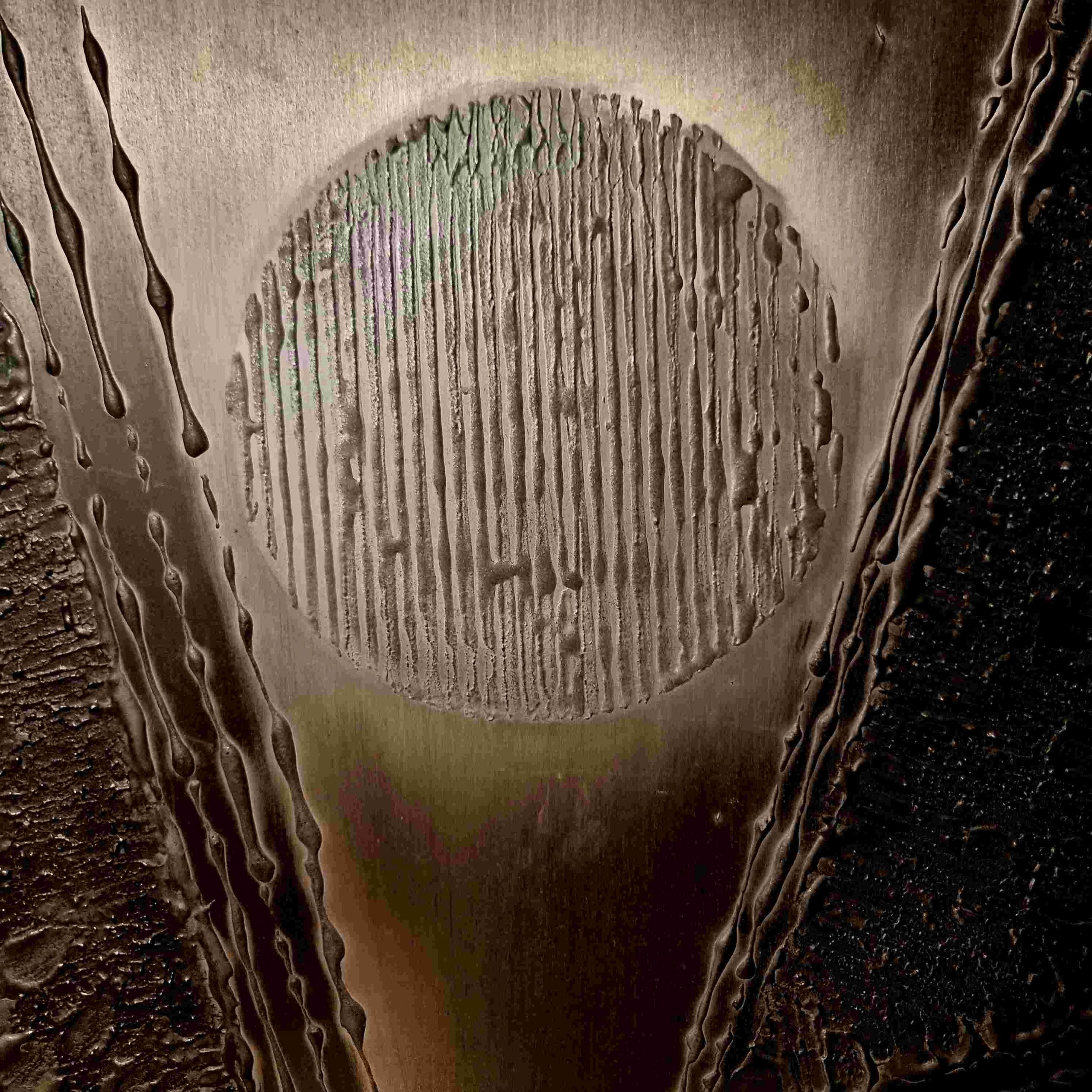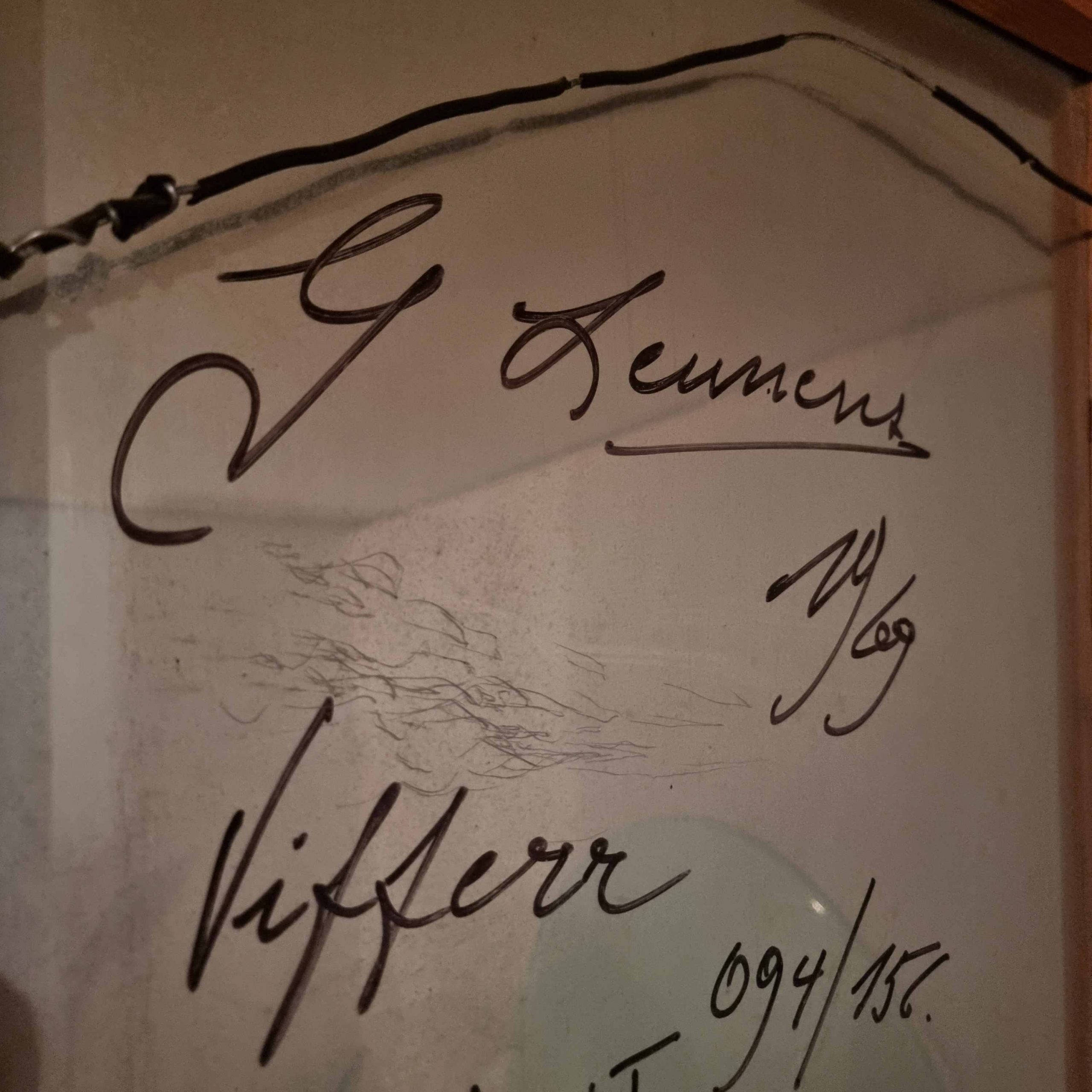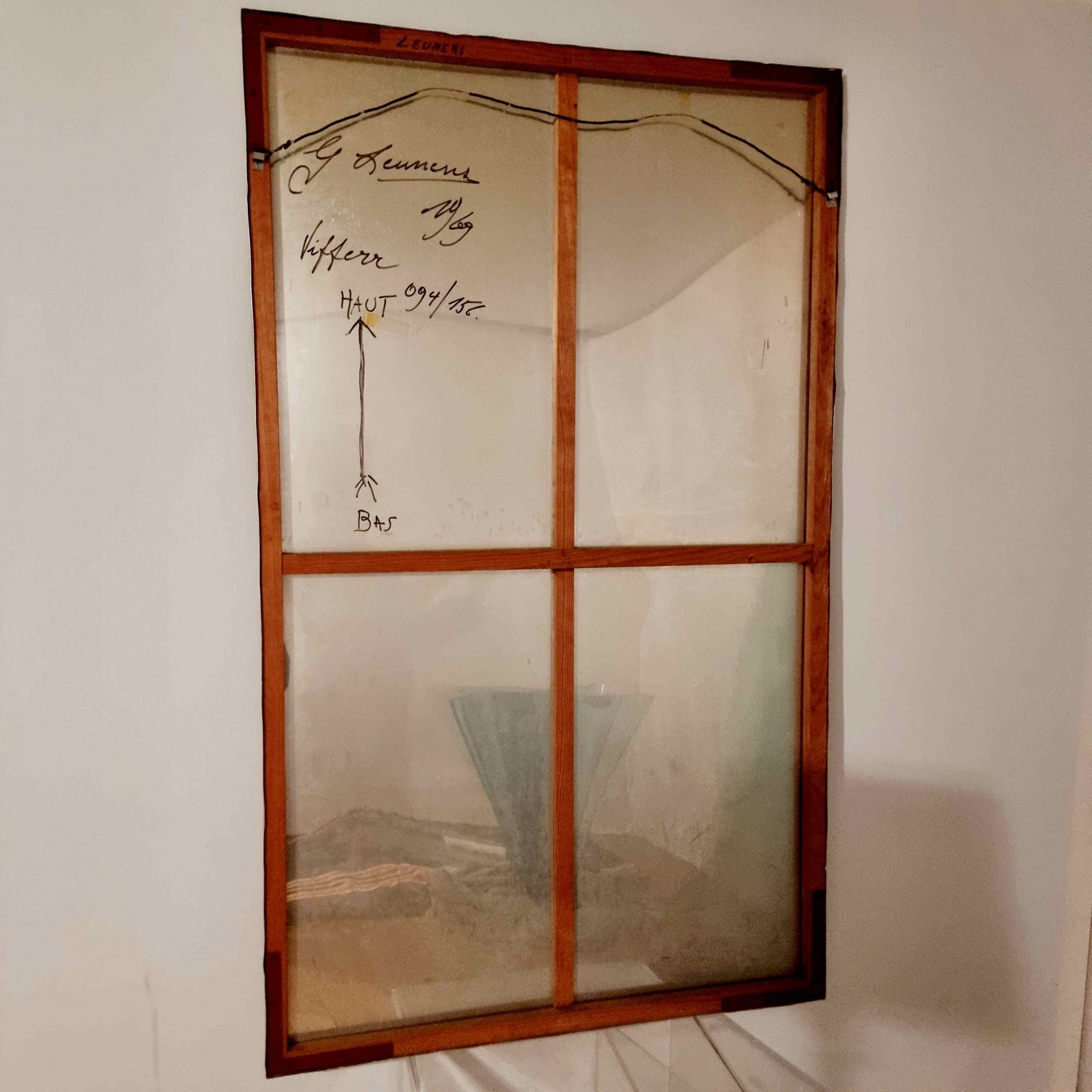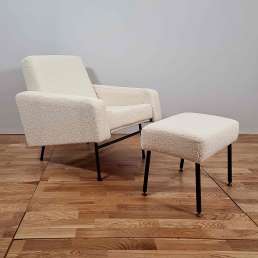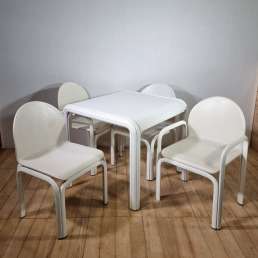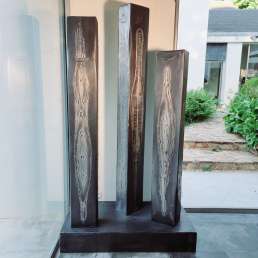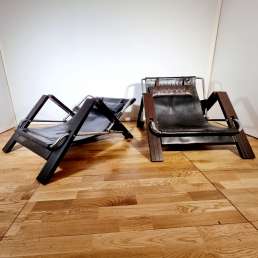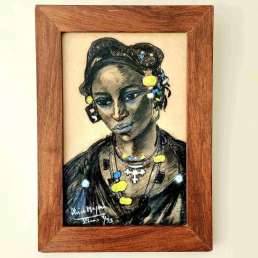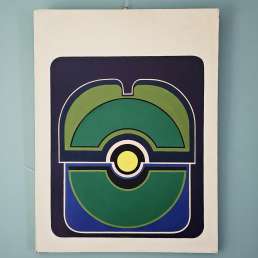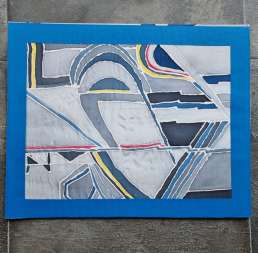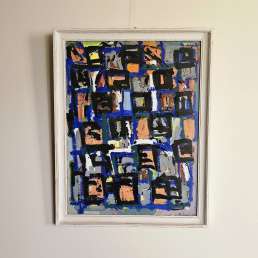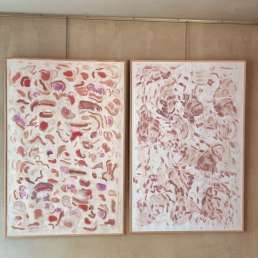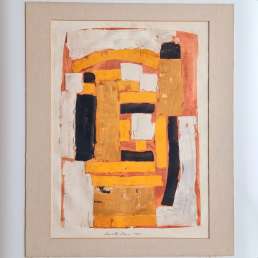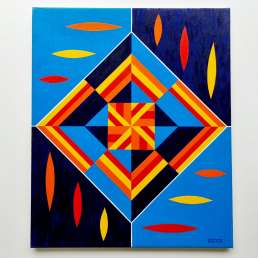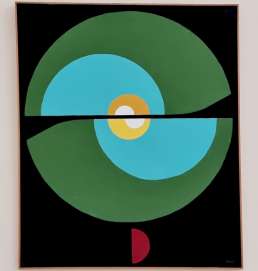SOLD – Guillaume LEUNENS (1914-1990), “Viffer-69” (Viper-1969), metal on metalillaume LEUNENS (1914-1990), « Viffer-69 » (Vipère-1969), métal sur métal
Description
What I like
First of all, I like this singular work for the very unusual work of the metal, patinated, with controlled drips, on this aluminum support. To date, it has not been possible to determine the creation process of Leunens! But his mastery, linked to his experience in the metal industry, is great.
Then, This painting is fascinating because thanks to its particular creative technique, mixing different materials and patinas, the light seems to really emanate from the painting, giving it a real presence: great art!!
Finally, I love the composition: these three circles of different sizes, included in a V pattern, itself embedded in portions of circles is beautiful, stable, almost abstract. Certainly, Leunens gave a title to his work, and we can see a triangular head of a viper in this work. But in my opinion, it is rather an abstract, rigorous work, which was titled after the fact: I do not see in it the portrait of a snake, possibly the idea of a snake. And more certainly work on straight lines and circles!
I like the gray and matte color of the painting, in all the diversity of the material and the different patinas: this work, all in all abstract, fits well into geometric abstraction, worked in a new spirit, in a material that is ultimately little used. in painting, more in the furniture of this period: metal.
Technical description
Guillaume LEUNENS (1914-1990)
Viffer- 69
(Viper-1969)
Cast metal, patinated and worked on aluminum sheet, folded on a wooden frame
Signed, titled, dated and dimensions on the reverse
Dimensions and weight
Height: 156 cm – Width: 94 cm – Depth: 3 cm
Weight: 7 kg
Mix & Match
Of course, we can think of a tribute to Leunens and hang this painting-sculpture in the same room as the monumental sculpture by the same artist, Colonnes 1966. The same astonishing work on metal, the same hesitation between abstraction and figuration, the same colorful range: alongside them will be placed works that are very virginal: I’m thinking of the set of G10 armchairs by Pierre Guariche and the Troika ottoman by Paul Geoffroy, upholstered in the famous French terry cloth by Bisson Bruneel. Or the Orsay set by Gae Aulenti, which certainly dates from 1976 but is another way of using metal: white lacquer.
We can also concoct a chic and austere atmosphere by using the pair of Grasshopper armchairs by Sonja Wasseur, with straight and curved lines, and a chrome and brown-black palette…
But why not dare the orange of our lacquered metal and white plastic low chairs from the 1970s, or that of the Sling bench by Bruce Hanah and Andrew Morrison! Or the peacock blue of the woolen cloth of our pair of G10 armchairs, again by Pierre Guariche!
I would gladly hang Edgard Pillet’s Composition on the wall with its colorful geometric abstraction: what an awakening it would be!
From the ceiling, to complete the different uses of metal, I would hang the Cubico chandelier by Gaetano Sciolari, with brushed metal and blue and white Murano glass!
In the center of the room, why not place the fun coffee table by Ludovico Acerbis with chrome cylinders and a central pattern in brushed metal? Here too, the creator has a science of metals!
Description
To know more
The artist
Self-taught, born in Belgium in 1914, placed in an orphanage with his brothers and sisters, he worked in metal from a very young age. He was very marked by the 1939 war during which, as a prisoner, he worked in a foundry. Although essentially self-taught, he took evening classes at the Ecole des Beaux-Arts in Brussels.
He exhibits a few times a year in artists’ clubs. In one of his exhibitions, he meets Magritte with whom he befriends for a few years. He likes to experiment, from figurative to abstract through surrealism. Among his influences are Permeke, Breughel, Picasso and Van Gogh. The criticism is laudatory and Leunens is requested by art galleries. Starting from Flemish expressionism, he evolved towards abstract art and his meeting with Servranckx allowed him to discover his own way.
He obtained a scholarship from the Belgian government in 1957 to study Spanish artistic techniques in Majorca. He then meets a rich French bourgeois whom he will marry after the divorce of his first marriage. Thanks to his new wife, he devotes all his time to art.
In 1958, Guillaume Leunens tears himself away from the vision of nature. We then notice him grasping the very essence of the absence of light. In many experiments with paint, heated iron and aluminum, glass or copper and even with ingredients like ink, wax, crushed coffee beans, it smears dark surfaces and yet vibrant, whose dark aspect is made even more enigmatic by light lines or colored dots. In his best productions, Guillaume Leunens already manages to evoke his fascination for the total night.
In 1960, he begins to work on metal, being convinced that our time requires specific pictorial means. He then transposes his paintings on metal, a material he has known since his youth. Aluminum plates receive its primitive geometric shapes, circles, distended squares, diagonal rectangles, diagonals, parallel lines, transversals, squares, perspective trapezoids, truncated and shortened cones. They reveal a poetic essence; despite the seemingly dry geometry, they give the prosaic aluminum a strong dose of human warmth.
Metal and fire, introduced by his first jobs as a worker, influenced the originality of Leunens’ work. It seems logical that the choice of this material encouraged him to participate in new research by iron sculptors. However, his orientation was quite different because, when he began his experiments, Leunens was already a painter. If he wishes to abandon the traditional means of painting which he considers, for him, outdated, he nevertheless attaches himself to respect for pictorial expression while developing new techniques which, in his opinion, would better adapt to the modern style.
Guillaume Leunens began experimenting with metal in the 1960s. He used a large sheet of aluminum stretched over a wooden frame as a backdrop. He uses several methods to successfully paint with metal on aluminum. He probably found his technique while working in foundries for the Germans. The result is spectacular, among his most beautiful works. He also creates base and wall sculptures with the same technique. He even manages to produce metal works on canvas and metal works on paper.
The techniques of metal on paper and metal on canvas are his best kept secrets, which he has never shared. In his studio when he works, no one is tolerated. He likes to paint the woman, the mother and her child as well as the design, probably due to his youth without his mother. He is also obsessed with space and everything related to it. He has an avant-garde vision. He is known as the painter of night and space.
After taking part in the Universal Exhibition in Montreal in 1967, while he was exhibiting in New York, two professors from Harvard University asked him if he could, with his metal on aluminum technique, create two works representing healthy cells. and cancer using slides. He created two large works, one for each type of cell for teachers who were greatly impressed by the resemblance of Leunens’ works to real cells.
Around the mid-1970s, he began to use another technique on his aluminum works, monotypes, which reveal the harmony of the lines. Leunens also uses this technique on paper demonstrating the versatility of the artist. The “monotypes” are the surprising and fascinating result of a new, entirely personal technique: the hands of a painter from Leunens forced the metal (aluminum) to behave like an oil colour. The name “monotype”, wrongly given, according to some, suggests a link with graphic art which is totally absent. In the work of Leunens the paintings are undoubtedly abstract and another name should be used.
A hard worker, Guillaume Leunens paints a work for days then, when the work is finished, he looks at it and if he does not find it up to the task, destroys it and starts another one or quite simply invents another technique. His determination, his patience, but above all his passion for his art and his vision of the universe are the main qualities that allowed Guillaume Leunens to achieve his dream.
He always fought for his art by pushing his own limits, he always wanted to do better. He was at the forefront when he was alive and he still is today. He took all his secrets with him. On his deathbed in 1990 he said: “My son, many have tried to imitate me but no one has ever succeeded. There are still some who will try but they will not succeed. His works will continue to stir in us all the emotions that this being passionate about life and the night was able to breathe into his art.
His inspiration was nourished by the experiences of the worker-artist in Belgian Brabant. He was fascinated by fire and metal, during the day, in the factory; at night, these images pursued him during his creative efforts. At that moment, man’s mastery over matter finally pushed him to artistic triumph.
Contacted in 1996 by the Leunens family, the members of Artmetal, an international group of artists working with metal located in Washington, were impressed by the works of Guillaume Leunens. Without welding or repoussé, the members of Artmetal wonder how Leunens applies metal to aluminum. The president then invites the family to bring works to their Washington convention which takes place a few months later. In the meantime, everyone gives their ideas on Guillaume Leunens’ technique. Dr. Mark Parmenter, a metallurgical engineer at NASA, even claims that he will find the technique in less than 15 minutes if he can see and touch the works. The family therefore brings 6 works to the convention and after three days, no hypothesis has been made.
Later, the members of Artmetal continue the experiments on their own to try to reproduce the same technique. After two years of research, they still haven’t found Guillaume Leunens’ technique. The general hypothesis suggests that he learned his technique while imprisoned in German labor camps during World War II. Probably an old technique which would have been lost after the death of Leunens.
Two publications: “Guillaume Leunens” by M.van Jole and “Leunens, painter of life” by Xavier Franc, tell us about his work.
A beautiful and authentic work of art at a fair price
Our work by Guillaume Leunens has been carefully selected for its aesthetic qualities, its originality and its fair price. Our choice favors above all the originality of a work, of a vision of an artist still too little known, guarantee of a valuation of your new acquisition in your interior and of an ability to dialogue with your furniture, to match and mix to create a unique decoration.
Buying works from 1970 is surely a reasonable investment, so great is the appetite for this period.
Finally, buying modern works preserves the resources of planet earth.
Additional information
| Weight | 7 kg |
|---|---|
| Dimensions | 94 × 156 cm |
| Créateur | |
| Epoque | |
| Matières | |
| Editeur |


